What Are the Common Problems with the 2017 Chevy Malibu? A Complete Overview

Overview
The 2017 Chevy Malibu is commonly associated with several issues, including:
- Transmission problems
- Electrical system malfunctions
- Battery failures
These features significantly impact the vehicle’s reliability and owner satisfaction. For instance, many owners report:
- Difficulties in shifting gears
- Unexpected engine shutdowns
- Rapid battery depletion
Such concerns highlight the importance for prospective buyers to be aware of these issues before making a purchase decision. Understanding these problems can help consumers make informed choices, ensuring they select a vehicle that meets their needs.
Introduction
The 2017 Chevrolet Malibu stands out as a strong contender in the midsize sedan market. It seamlessly combines sleek design, comfort, and advanced technology. Featuring a variety of trims and engine options, including a turbocharged variant, the Malibu caters to diverse driving preferences. Additionally, it offers ample interior space for both passengers and cargo, enhancing its appeal.
However, potential buyers should be aware of the mixed reliability ratings and common mechanical issues that may affect their ownership experience. From electrical system malfunctions to transmission troubles, understanding the nuances of the Malibu’s performance is essential for making informed decisions.
This article explores the key features, reliability concerns, and maintenance tips for the 2017 Malibu. It aims to provide a comprehensive overview for prospective owners, helping them make the best choice for their needs.
Overview of the 2017 Chevy Malibu: Features and Specifications
The 2017 Chevrolet model is a midsize sedan that effectively combines style, comfort, and advanced technology. It is offered in multiple trims—L, LS, LT, and Premier—providing a variety of engine options, including a 1.5-liter turbocharged four-cylinder and a robust 2.0-liter turbocharged engine. This versatility accommodates different driving preferences and needs.
Inside, the vehicle is designed with spaciousness in mind, offering ample room for both passengers and cargo. As editor Jennifer Geiger notes, “Ample space and easy-to-access lower Latch anchors add a measure of family-friendliness to the sedan.” The car is equipped with advanced safety features, ensuring peace of mind for families and commuters alike.
The intuitive infotainment system enhances the driving experience, featuring a standard rear view camera and available adaptive cruise control. The user-friendly touchscreen interface simplifies navigation and access to entertainment, making it easier for drivers to stay connected.
Fuel efficiency is a significant advantage of this vehicle, with highway ratings reaching up to 36 mpg, appealing to budget-conscious buyers. Additionally, the 2017 hybrid variant presents a unique combination of efficiency and comfort, featuring a gas/electric I4 engine and a starting price of $28,750. This hybrid model also boasts a trunk capacity of 11.6 cubic feet and electric rack and pinion steering with a turning diameter of 2.8 turns from lock to lock, ensuring both practicality and ease of handling.
Overall, the 2017 Chevrolet vehicle is a compelling choice for those seeking a reliable, stylish, and economical sedan. It is backed by positive consumer reviews and expert opinions that highlight its family-friendly design and user-centric features. For those considering additional expenses, it’s worth noting that the Front License Plate Bracket costs $40, an important consideration for budget shoppers.
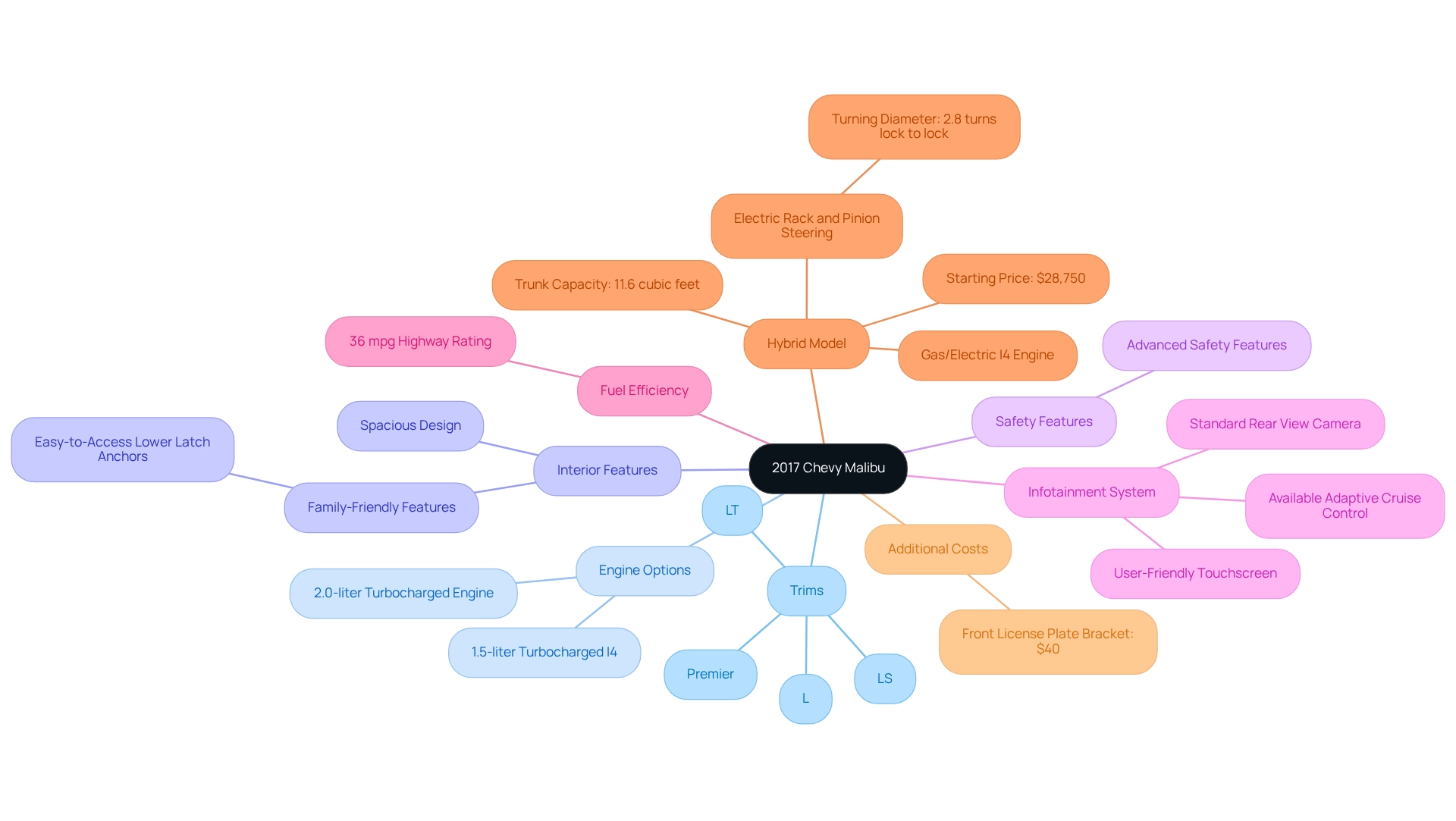
Reliability Ratings: How Does the 2017 Chevy Malibu Perform?
The 2017 Chevy Malibu presents a variety of common problems that have influenced its reliability ratings from multiple sources, resulting in a mixed bag of owner experiences. Consumer Reports assigns the vehicle an average reliability rating within its category, indicating that while many drivers appreciate its features, some have encountered common issues, particularly with the electrical system and transmission. J.D. Power’s evaluations further illustrate this contrast; the vehicle shines in comfort and technology, showcasing a MyLink touchscreen interface available in 7- and 8-inch sizes. However, it has faced significant challenges concerning engine performance and overall durability.
For prospective buyers, these ratings hold substantial importance, especially for those considering long-term ownership. Reports of electrical malfunctions, including intermittent failures of the keyless entry fob without battery issues, are among the common problems that raise concerns about the vehicle’s reliability. A review of the 2017 Chevy Malibu’s issues brought to light serious concerns, such as vibrations and a loss of power, which can lead to a blown motor and dissatisfaction with GM’s customer service.
As one anonymous reviewer pointed out, the vehicle earned ratings of 4.0 for comfort and 5.0 for interior performance. However, these positives must be balanced against the potential reliability issues that may arise over time.
These insights highlight the necessity of thorough research before making a purchase. While the vehicle offers firm, supportive front seats and reasonable rear seating comfort for average-sized adults, potential owners should remain aware of the common problems discussed regarding its reliability as of 2025. Staying informed about long-term ownership experiences and expert evaluations is essential for making informed consumer decisions.
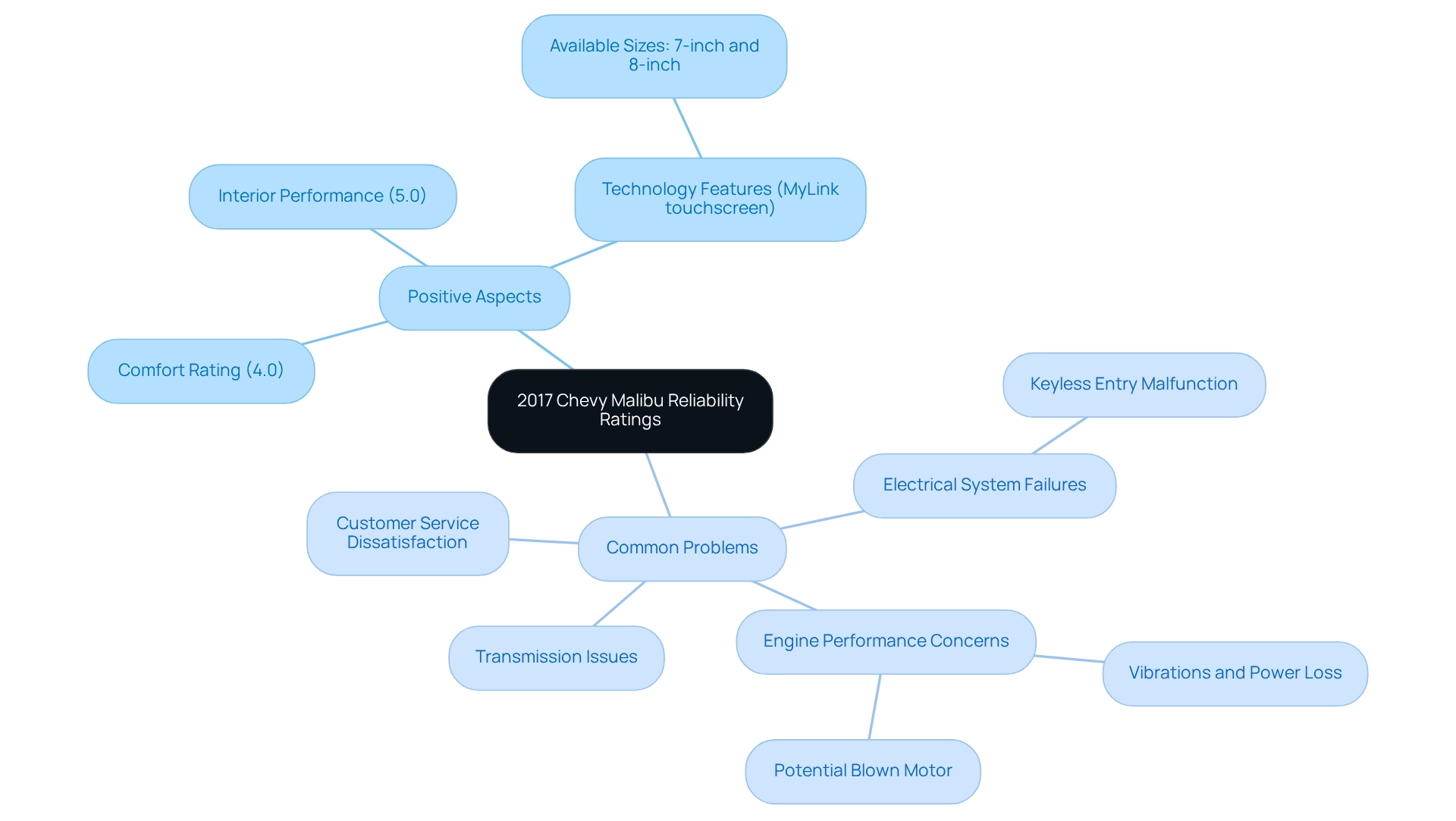
Common Mechanical Problems Reported by Owners
A variety of mechanical issues, commonly referred to as 2017 Chevy Malibu common problems, have been frequently reported by owners, impacting both performance and reliability. One notable issue involves the transmission, with many drivers experiencing difficulties in shifting gears. A particularly frustrating aspect of these common problems is the ‘Shift to Park’ alert, which can activate even when the car is correctly positioned in gear, leading to confusion and inconvenience.
Engine stalling is another prevalent issue among the 2017 Chevy Malibu common problems, especially noted during idling or when the auto-stop feature is engaged. This can pose safety risks and disrupt the overall driving experience. Additionally, excessive oil consumption is a significant concern, affecting engine performance and potentially leading to costly repairs if not addressed promptly.
Fuel system issues have also emerged as part of the 2017 Chevy Malibu common problems, contributing to unexpected performance drops and the illumination of check engine lights. These mechanical challenges can lead to a difficult ownership experience, as highlighted by a case study of a couple who faced ongoing repairs. They reported that the check engine light reactivated shortly after a service visit, raising concerns about reliability as their warranty neared expiration.
This situation left them anxious about potential repair expenses once the warranty concluded, despite the vehicle’s commendable fuel efficiency. Data suggest that the transmission-related issues are not isolated events, with many individuals expressing dissatisfaction regarding the overall quality of the car. Furthermore, a class action lawsuit is currently in litigation concerning problems with the vacuum pump linked to the brakes, underscoring persistent legal challenges associated with the automobile.
Testimonials from owners further emphasize these concerns, with many sharing experiences of frequent repairs linked to the 2017 Chevy Malibu common problems and the associated stress. However, it’s important to note that some individuals, like Maggie, have had favorable experiences with the car’s safety features. She stated, “This style vehicle is not only stylish but safe, and I would recommend this vehicle to any and everyone.”
As such, prospective buyers should be aware of the 2017 Chevy Malibu common problems, as these issues can significantly impact the driving experience and lead to unexpected expenses.
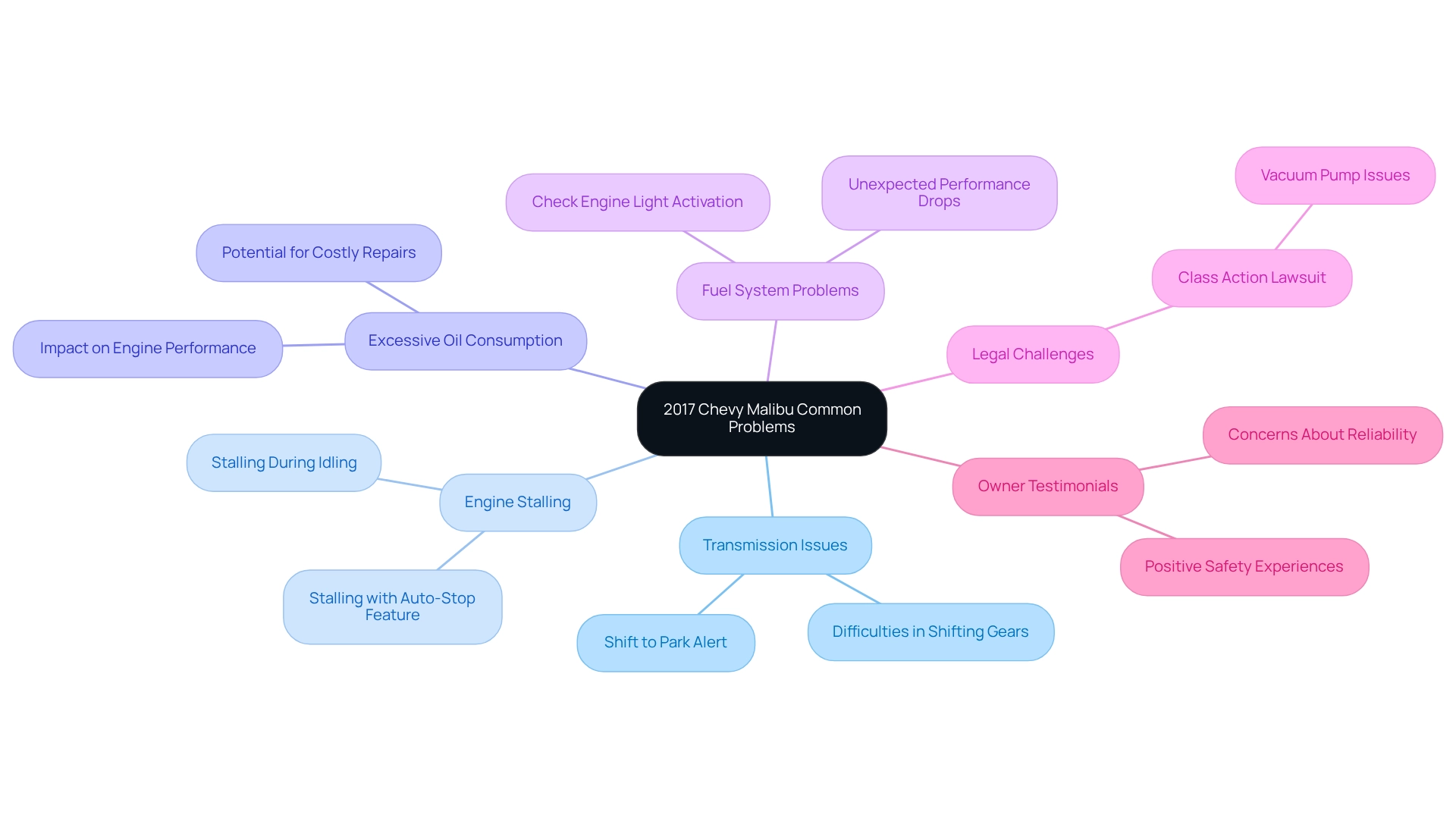
Electrical System Issues: What to Look Out For
Electrical system problems are among the most frequently reported concerns with the 2017 Chevy, significantly affecting user satisfaction. Many drivers have encountered unexpected engine shutdowns, particularly when the auto-stop feature is engaged, raising concerns about reliability. Reports indicate that these shutdowns can occur without warning, leading to potentially dangerous situations on the road.
In addition to engine shutdowns, battery drain has emerged as a frequent complaint, often attributed to faulty alternators or wiring defects. Owners have noted that these electrical failures can lead to a cascade of problems, including malfunctioning dashboard lights and an unresponsive infotainment system, which may freeze or fail to operate altogether. With a Manufacturer’s Suggested Retail Price (MSRP) of $30,975, the 2017 Chevy Premier model represents a significant investment for budget-conscious shoppers.
A case study highlights the experience of a 2017 model owner who faced severe vibrations and a loss of power shortly after purchase. This user reported engine problems that resulted in a blown motor, exacerbated by insufficient service from the dealership. Such experiences underscore the importance of addressing electrical problems swiftly, as they can not only reduce performance but also present considerable safety hazards.
Statistics indicate that electrical issues are common in the 2017 Malibu, with a notable frequency of complaints concerning the electrical system. Expert opinions suggest that although the automobile offers numerous appealing features, including standard voice controls that are somewhat stilted and necessitate the use of specific phrases, the dependability of its electrical components remains a significant concern for prospective buyers. As proprietor assessments continue to differ—some commending the performance while others express dissatisfaction—it is crucial for budget-conscious buyers to evaluate these elements thoughtfully when contemplating a purchase.
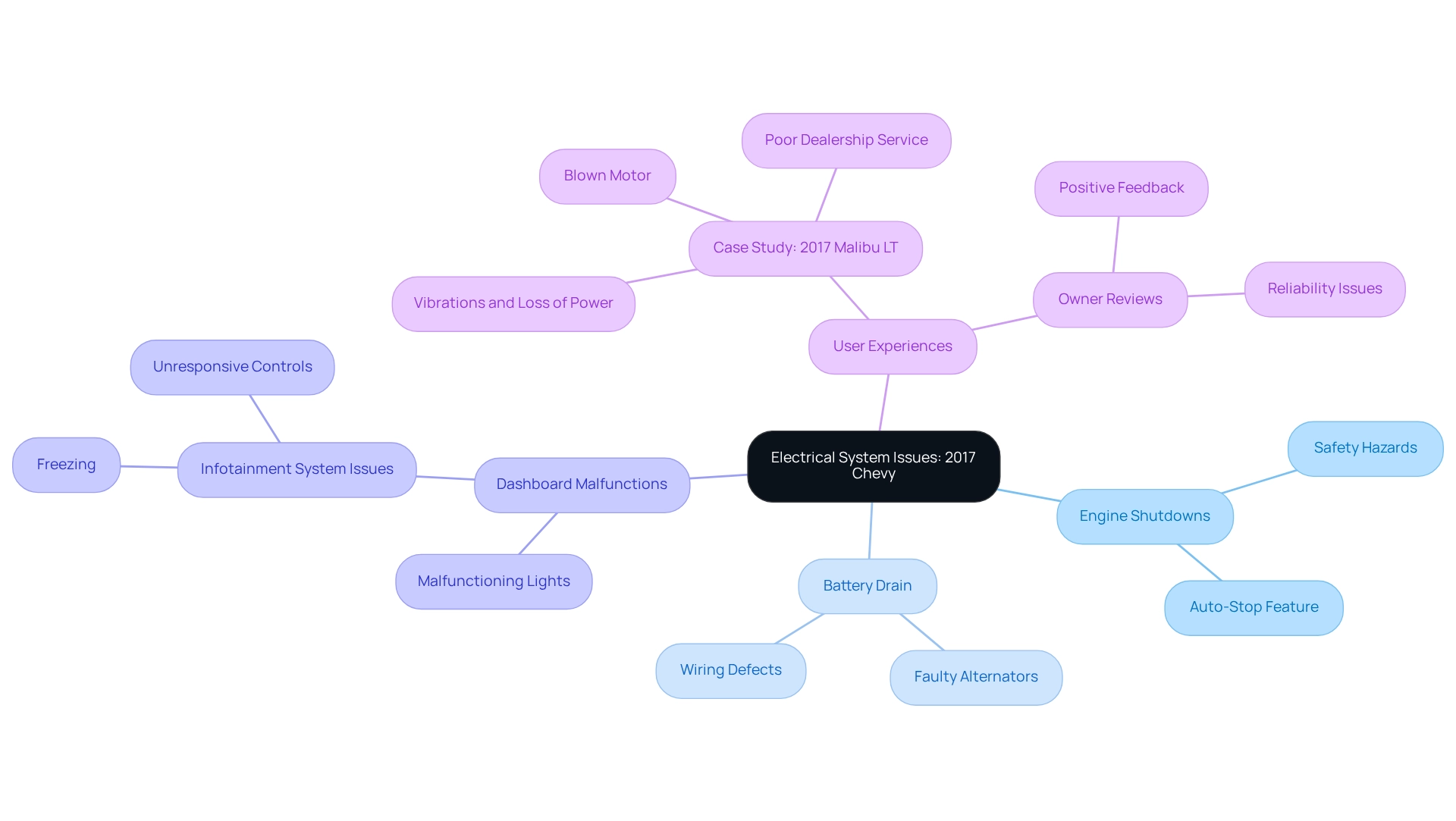
Battery Problems: Signs Your 2017 Chevy Malibu Needs Attention
Battery problems are among the common issues faced by owners of the 2017 Chevy Malibu, particularly those with hybrid models. Symptoms indicating battery problems often include slow engine cranking, dashboard warning lights, and a complete failure to start. Many drivers have reported rapid battery depletion, frequently linked to the vehicle’s electrical system drawing power even when the engine is off.
Data indicates that a significant number of owners have encountered these common problems, with a recall affecting 426,240 vehicles in the United States. This emphasizes the importance of diligent battery maintenance.
To mitigate potential battery issues, routine maintenance is crucial. This includes:
- Checking battery connections for corrosion
- Ensuring the battery is properly charged
- Monitoring the electrical system for any unusual activity
If any signs of battery trouble arise, such as dimming headlights or difficulty starting the engine, it is advisable to have the battery tested promptly.
Replacing a failing battery before it leads to being stranded can save both time and stress.
Expert guidance underscores the importance of proactive maintenance for the battery in the 2017 Chevy Malibu. Regular inspections and timely replacements can greatly enhance the reliability of the vehicle. Chevrolet states that this model is equipped with a standard set of 10 airbags, along with essential stability and traction control systems, highlighting the importance of battery maintenance for overall vehicle reliability.
By staying informed about the common problems associated with the 2017 Chevy Malibu, particularly battery issues, and taking preventive measures, drivers can enjoy a smoother driving experience while avoiding the inconveniences linked to battery failures. Additionally, the vehicle’s overall design provides a larger greenhouse and visually balanced appearance, which can influence performance and user experience, including battery maintenance. Understanding the model’s evolution, such as the 2014 update that introduced new technology and enhancements, allows users to appreciate how advancements in battery technology can enhance their driving experience.

Transmission Troubles: Understanding Common Issues
Among the common problems reported by 2017 Chevy Malibu owners, transmission issues stand out as a significant concern. Many drivers have experienced difficulties, including slipping gears and delayed shifting. One prevalent complaint is the ‘Shift to Park’ alert, which often activates even when the vehicle is correctly positioned. This issue has been highlighted in various user reviews, emphasizing the frustration it causes among drivers.
Additionally, numerous individuals have reported harsh shifting, particularly when accelerating from a full stop. This can detract from the overall driving experience, raising questions about the vehicle’s reliability.
Data indicates that significant transmission issues are among the 2017 Chevy Malibu’s common problems. A recent lawsuit regarding the GM 8L90 transmission has progressed beyond a motion to dismiss, underscoring the seriousness of these concerns. While the Malibu is often praised for its cabin quality and comfort—making it comparable to an entry-level luxury car—its transmission performance has faced criticism, indicating a need for improvement.
User reviews reflect a mix of positive experiences with the Malibu’s performance and negative experiences related to reliability issues. Mechanics have noted that these transmission problems can lead to reduced fuel efficiency and overall performance. Therefore, it is crucial for individuals to closely observe their car’s behavior.
If any irregularities are detected, seeking professional assistance promptly is advisable to mitigate further complications. Furthermore, while standard voice controls may feel a bit stilted and require specific phrases, utilizing Apple CarPlay or Android Auto allows users to push-and-hold the same button to access Siri or Google Voice, which respond more effectively to natural-language requests. This aspect of user experience adds another layer to the overall evaluation of the automobile’s performance.
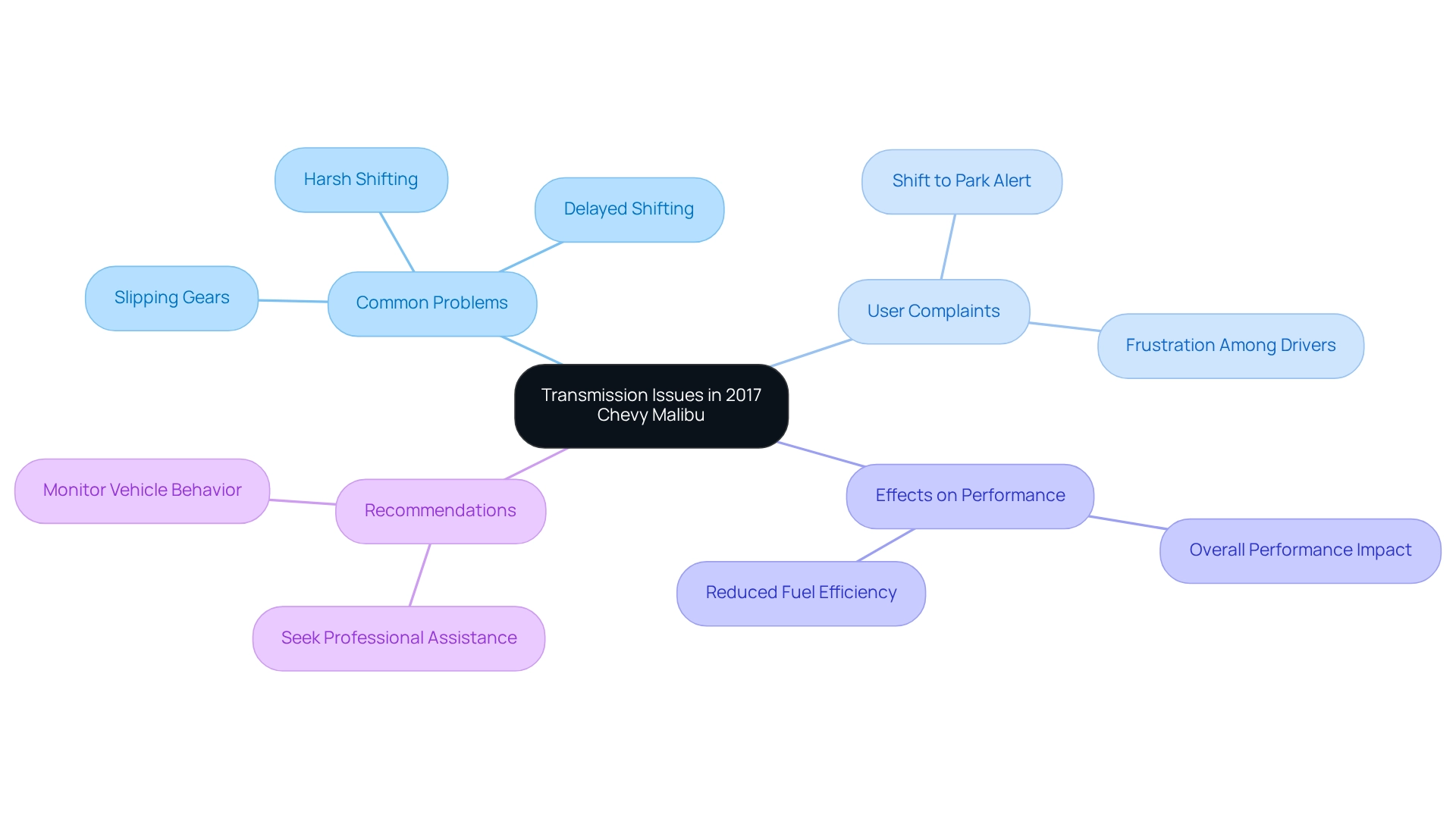
Safety Recalls: What You Need to Know
Owners of the 2017 Chevy Malibu should be aware of common problems, particularly several safety recalls that are crucial for ensuring the vehicle’s safety and dependability. Among the most significant recalls are those related to airbag deployment issues, specifically a recall concerning insufficient welds in the right-hand rear side airbag inflator manifold. This defect could potentially result in inflator failure or debris being propelled into the cabin during a crash, significantly increasing the risk of injury.
General Motors has initiated a recall for affected vehicles. They state, “is recalling certain 2012-2013 Buick Regal, 2013 Chevrolet sedan, and 2010-2013 Buick Lacrosse vehicles sold or ever registered in Connecticut, Delaware, the District of Columbia, Illinois, Indiana, Iowa, Kentucky, Maine, Maryland, Massachusetts, Michigan, Minnesota, Missouri, New Hampshire, New Jersey, New York, Ohio, Pennsylvania, Rhode Island, Vermont, Virginia, West Virginia, or Wisconsin.” They are offering free replacement of the rear side airbag modules; however, a notification schedule has not yet been provided.
In addition to airbag issues, the 2017 Chevy Malibu has recalls concerning possible electrical system malfunctions that could lead to stalling. This further highlights the necessity for caution among vehicle users. To stay informed about any open recalls, individuals can easily check the National Highway Traffic Safety Administration (NHTSA) website or reach out to their local Chevrolet dealer for assistance.
As of 2025, the 2017 Chevy sedan has recorded an average safety rating of 4.5 out of 5 from 37 reviews, indicating a generally positive reception despite the recalls. However, it is essential for proprietors to address any outstanding recalls swiftly, as they can present considerable dangers during operation. By staying proactive and informed, vehicle owners can enhance their driving experience and ensure their automobile operates safely.

Solutions and Maintenance Tips for Common Problems
To effectively address the common problems associated with the 2017 Chevy Malibu, regular maintenance is crucial. For battery issues, ensuring that connections are clean and secure is essential; having the battery tested annually can prevent unexpected failures. Regarding transmission concerns, it is vital to adhere to the manufacturer’s recommended service intervals for fluid changes, as neglecting this can result in significant wear and costly repairs.
Owners frequently report common problems with the 2017 Chevy Malibu, including:
- Fuel gauge inaccuracies
- Transmission faults
These issues can lead to increased maintenance expenses. Staying informed about recalls and responding promptly to any safety alerts can also mitigate serious issues in the future. Regular checks for software updates on the infotainment system can address minor electrical glitches, as noted by one owner who remarked, “the last two years times that screen goes black when backing up.”
Statistics indicate that the average yearly repair expense for a 2017 Chevy model is approximately $613, with specific repairs ranging from $44 for minor inspections to over $600 for more significant issues. Notably, the estimated cost for Rack and Pinion Replacement falls between $1,823 and $1,940. Additionally, the average insurance cost for a Chevrolet Malibu is about $2,449 per year, totaling around $12,245 after five years of ownership.
By following these maintenance tips, owners can enhance their vehicle’s performance and reliability while effectively managing long-term ownership costs.
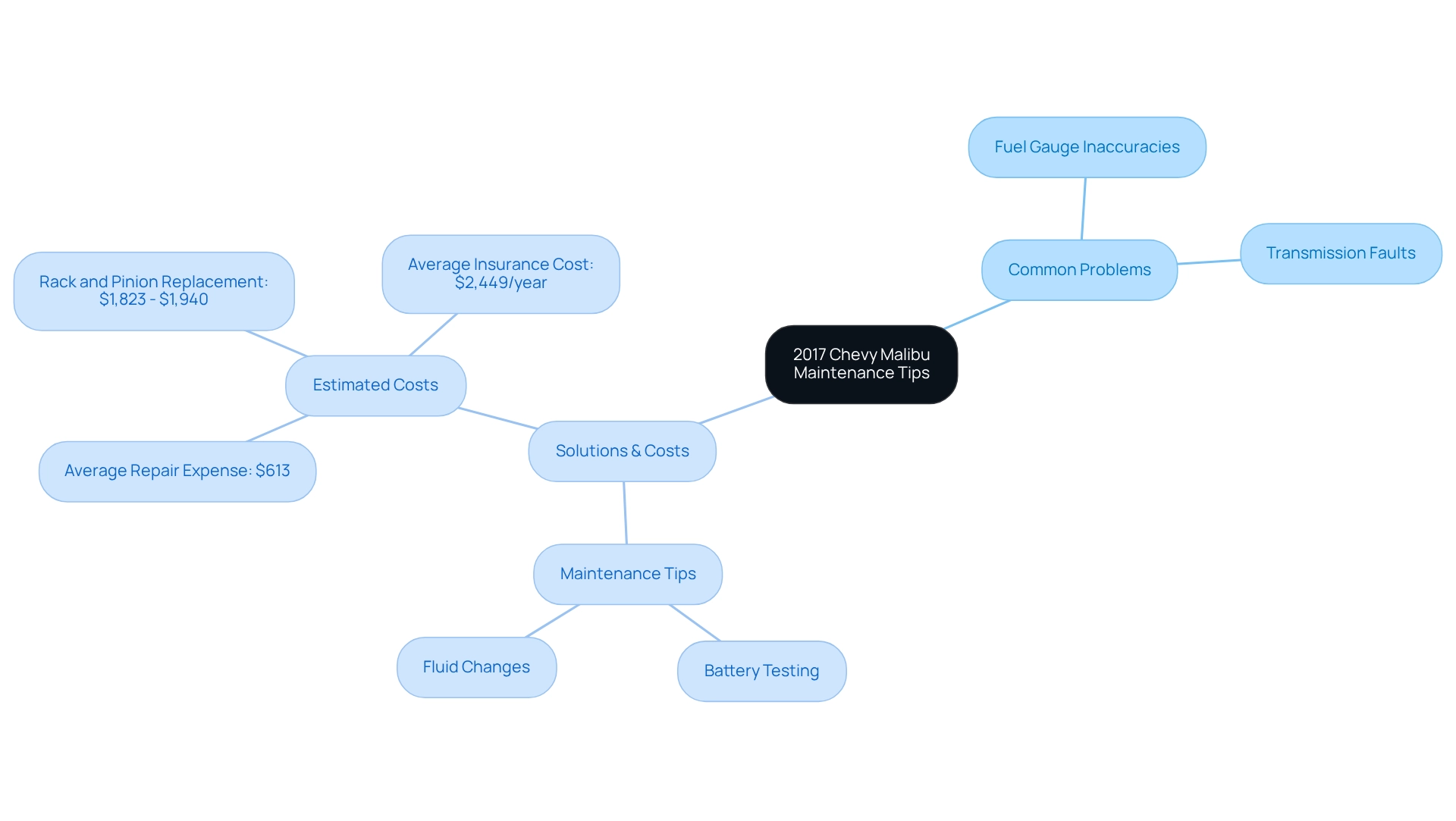
Conclusion
The 2017 Chevrolet Malibu offers a compelling package in the midsize sedan segment, featuring a blend of style, comfort, and advanced technology. Its diverse range of trims and engine options caters to various driving preferences, while the spacious interior and user-friendly infotainment system enhance the overall driving experience. Notably, fuel efficiency—especially with the hybrid variant—adds to its appeal for budget-conscious consumers.
However, potential buyers should carefully consider the mixed reliability ratings associated with the Malibu. Reports of electrical malfunctions, transmission troubles, and other mechanical issues have surfaced, indicating that while many drivers appreciate its features, others have encountered significant challenges. These concerns underscore the importance of thorough research and understanding the nuances of ownership before making a purchase decision.
To ensure a positive ownership experience, regular maintenance and prompt attention to any arising issues are crucial. By staying informed about recalls and common problems, owners can mitigate risks and enhance their vehicle’s reliability. Ultimately, the 2017 Chevy Malibu can be a stylish and economical choice, but prospective buyers should weigh its strengths against the potential for reliability concerns. This careful consideration will help them make an informed decision that aligns with their needs.
Frequently Asked Questions
What are the key features of the 2017 Chevrolet Malibu?
The 2017 Chevrolet Malibu is a midsize sedan that combines style, comfort, and advanced technology. It offers multiple trims (L, LS, LT, and Premier) with engine options including a 1.5-liter turbocharged four-cylinder and a 2.0-liter turbocharged engine. The vehicle is spacious, family-friendly, and equipped with advanced safety features.
How does the interior of the 2017 Chevrolet Malibu accommodate passengers and cargo?
The interior of the 2017 Chevrolet Malibu is designed for spaciousness, providing ample room for both passengers and cargo. It also features easy-to-access lower Latch anchors, enhancing its family-friendly design.
What technology features are included in the 2017 Chevrolet Malibu?
The 2017 Chevrolet Malibu includes an intuitive infotainment system with a standard rear view camera and available adaptive cruise control. The user-friendly touchscreen interface simplifies navigation and access to entertainment options.
What is the fuel efficiency of the 2017 Chevrolet Malibu?
The 2017 Chevrolet Malibu has impressive fuel efficiency, with highway ratings reaching up to 36 mpg. There is also a hybrid variant that combines efficiency and comfort with a starting price of $28,750.
What are some common problems reported with the 2017 Chevrolet Malibu?
Common problems reported with the 2017 Chevrolet Malibu include issues with the electrical system and transmission, as well as intermittent failures of the keyless entry fob. Some drivers have also experienced vibrations and loss of power.
How do reliability ratings for the 2017 Chevrolet Malibu compare?
The 2017 Chevrolet Malibu has received average reliability ratings from Consumer Reports, indicating mixed owner experiences. While it excels in comfort and technology, it faces challenges regarding engine performance and overall durability, according to J.D. Power evaluations.
What should prospective buyers consider before purchasing the 2017 Chevrolet Malibu?
Prospective buyers should conduct thorough research on the 2017 Chevrolet Malibu, considering both its positive features (like comfort and interior performance) and potential reliability issues. Staying informed about long-term ownership experiences is essential for making an informed decision.
What is the cost of the front license plate bracket for the 2017 Chevrolet Malibu?
The front license plate bracket for the 2017 Chevrolet Malibu costs $40, which is an important consideration for budget-conscious shoppers.





